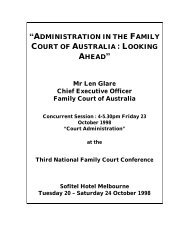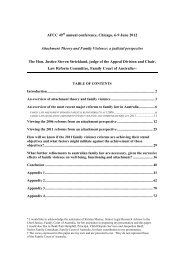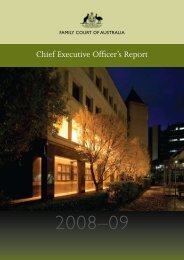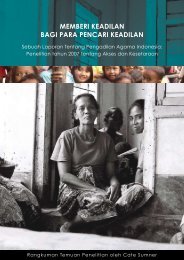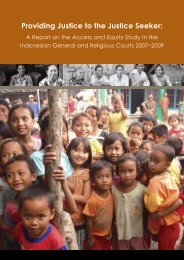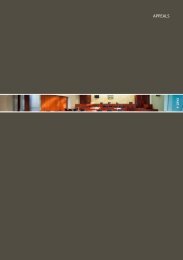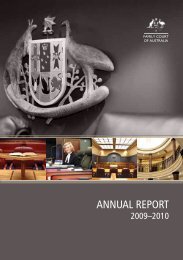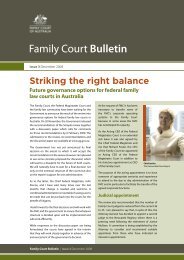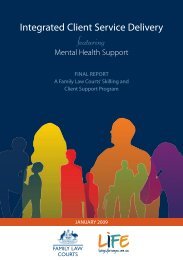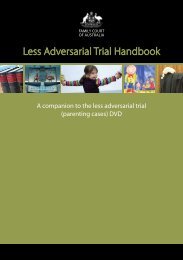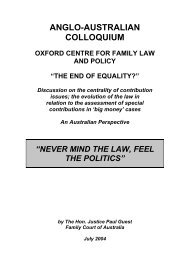View Part 8 - Appendices (PDF Size - 119 KB) - Family Court of ...
View Part 8 - Appendices (PDF Size - 119 KB) - Family Court of ...
View Part 8 - Appendices (PDF Size - 119 KB) - Family Court of ...
You also want an ePaper? Increase the reach of your titles
YUMPU automatically turns print PDFs into web optimized ePapers that Google loves.
Other committees<br />
The <strong>Court</strong> has a number <strong>of</strong> other permanent Committees that meet by telephone on a<br />
regular basis or as required, after court hours. They are:<br />
Appendix 1: court committees AND PUBLIC SUBMISSIONS <strong>Part</strong> 8<br />
Aboriginal and Torres Strait Islander Committee (Chair: Justice Moore)<br />
Access to Justice Committee (Chair: Deputy Chief Justice Faulks)<br />
Communications Committee (Chair: Chief Justice Bryant)<br />
Electronic Benchbook Committee (Chair: Justice Rose)<br />
Ethics and Research Committee (Chair: Justice Morgan — until February 2006,<br />
Judicial Registrar Smith — from February 2006)<br />
<strong>Family</strong> Violence Committee (Chair: Justice Moore)<br />
Information and Communication Technology Committee<br />
(Chair: Deputy Chief Justice Faulks)<br />
Judgment Publication Committee (Chair: Justice Finn)<br />
Law Reform Committee (Chair: Justice O’Ryan — until March 2006,<br />
Justice Carmody — from March 2006)<br />
Library Committee (Chair: Justice Finn)<br />
National Case Management Committee (Chair: Deputy Chief Justice Faulks)<br />
Pr<strong>of</strong>essional Development Committee (Chair: Justice Warnick)<br />
Property Management Committee (Chair: Justice Dawe)<br />
Committee highlights<br />
The Communications Committee was established in 2005-06 to develop and<br />
implement policies concerning the handling <strong>of</strong> media issues, the reporting <strong>of</strong><br />
proceedings and communicating the <strong>Court</strong>’s function and role to clients, external<br />
stakeholders and the media. Committee members participated in a one-day workshop<br />
in May 2006 to discuss and decide on key elements <strong>of</strong> the <strong>Court</strong>’s communications<br />
and external positioning approach, as well as informing the future direction <strong>of</strong><br />
communications activities.<br />
The Pr<strong>of</strong>essional Development Committee meets regularly to discuss policies and<br />
programs designed to support judging and judicial development. The Committee<br />
also plays an important role in developing education programs for the Judges’ Annual<br />
Conference.<br />
During 2005-06, the <strong>Family</strong> Violence Committee supervised the application <strong>of</strong> the<br />
<strong>Court</strong>’s <strong>Family</strong> Violence Strategy. It was also engaged in developing guidelines for<br />
the final phase <strong>of</strong> the Strategy — case management — and for the implementation<br />
<strong>of</strong> section 60K <strong>of</strong> the <strong>Family</strong> Law Act, which requires the <strong>Court</strong> to give prompt<br />
consideration to allegations <strong>of</strong> family violence or child abuse.<br />
162<br />
<strong>Family</strong> <strong>Court</strong> <strong>of</strong> Australia Annual Report 2005–2006



